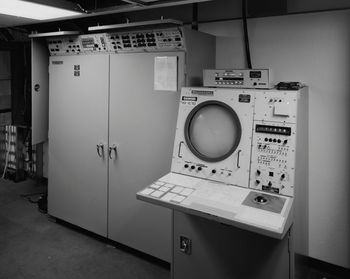FYQ-47
|
FYQ-47 - A joint use USAF/FAA Radar Video Data Processor (RVDP), used at joint-use radar sites as the FYQ-47, and to FAA only sites as the FYQ-49, built by Burroughs Corporation. Known as the Common Digitizer. Common Digitizer EvolutionThe common digitizer program began in the 1960s with the development of the FYQ-40 as a small set of prototype machines. In 1967, two of the FYQ-40s were sent with two BUIC II systems into the Vietnam War theater, one at Monkey Mountain and the other at Udorn RTAFB. The FYQ-40 was second generation (transistor) electronic equipment. The FYQ-47 program was implemented in the late 1960s and early 1970s to replaced the aging FST-2s that were rapidly becoming unsupportable. The FYQ-49 was a version of the FYQ-47 without the height-finder interface and was deployed to FAA sites without separate height-finder radars. The FYQ-47 and FYQ-49 were integrated circuit single-channel radar data digitizers. FYQ-47 - FST-2 Replacement ProgramIn February 1973 the Air Force and the FAA completed an 18-month replacement program, swapping the aging vacuum tube FST-2s with integrated circuit FYQ-47s and FYQ-49s. The Air Force purchased a total of 83 common digitizers at a cost of $16 million dollars. The FAA purchased an unrevealed number of slightly different and smaller versions for civil air traffic control at a cost of $ 11 million dollars. Air Force FYQ-47s were maintained by Air Force technicians with an Air Force Specialty Code of 305X4 but as the USAF radar sites were transitioned to the FAA or closed completely training transitioned to the FAA in the 1980s. JSS SystemIn 1982 the SAGE System was being deactivated and the JSS System was coming into being using joint-use (FAA/USAF) radar sites. JSS System planning included some 32 FYQ-47s and only 4 FYQ-49s. The 1982 plans broke out the 46 JSS Radar sites as:
46 Total Sites Note: The 10 ARSR-3 radar sites included in the 36 USAF/FAA Joint Use Sites did not require FYQ-47/49 digitizers because the ARSR-3 radar included digitizer functionality. CD-2On 6 Apr 1979, the FAA announced the award of a contract for a second-generation common digitizer (CD-2). The CD-2 was to be dual channel and microprocessor driven. The contract was for 106 of the CD-2s to be installed at long-range radar sites. The first units were delivered to radar sites in May 1984 and the FAA commissioned the two first CD-2s in March 1986.
See Also: Sources: Links:
|
